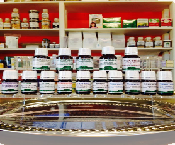
|
|
|
|
|
|
|
|
|
|
|
|
|
|
|
|
|
|
|
|
|
|
|
|
|
|
|
|
|
|
|
|
|
|
|
|
|
|
|
|
|
|
|
|
|
|
|
|
|
|
|
|
|
|
|
|
|
|
|
|
|
|
|
|
|
|
|
|
|
|
|
|
|
|
|
|
|
|
|
|
|
|
|
|
|
|
|
|
|
|
|
|
|
|
|
|
|
|
|
|
|
|
|
|
|
|
|
|
|
|
|
|
|
|
|
|
|
|

Absinthe (Wormwood/Mugwort) oil, Wild, USA
 |
| Click to enlarge image(s) |
Absinthe (Wormwood/Mugwort) oil, Wild, USA
Category Essential Oils
Species Artemisia absinthum L., fam.
Asteraceae (Compositae)
Part Flowering Tops
Method Steam Distilled
Class Ketone
Country USA
Code ArtAbs9
Absinthe (Wormwood/Mugwort) oil.
True Ansinthe or Wormwood is native to Europe but commonly referred to as Mugwort (although technically incorrect) in the USA, where it now grows as a weed and is also cultivated.
This oil should not be confused with the Chinese so called "mugwort" or "absinthe" oil which is derived from a different species and contains about 40% borneol. Which is much cheaper in cost, then the oil coming from China should not even be referred to as Absinthe (or Mugwort) because it is chemically very different than that of true absinthe oil.
For centuries in Europe this herb was used to treat a host of diseases and disorders including intestinal worms, gout, jaudice, kidney stones, pain and swelling suppression, promotion of menstruation, as an antidote for drunkenness and various poisons, as a bitter tonic, appetite stimulant, external antiseptic and as strewing herb to mask bad odors and drive away vermin.
The oil is steam distilled from leaves and flowering tops of the dried herb. The quality wormwood oil will vary with the condition of the herb and yields are generally low, in the range of 0.27 - 0.40% by weight.
The oil is very dark green to bluish - green color with an intensely herbaceous - green, sharp and fresh top note.
The odor is reminiscent of cedar leaf oil but not as sweet and more dry - woody in the body note, giving a very interesting and unique odor for perfumery. The bluish - green color is due to the presence of a small amount of Chamazulene (generally less than 1%), which is not present in the herb itself, but generated from Artabsine during the distillation process.
The main component of the oil is beta - thujone (typically 35 - 50%), a known neurotoxin, and it is because of this that the notorious liqueur known as Absinthe was banned first Switzerland then in the US and finally in France in 1915 which greatly reduced the world production of the oil.
Most all the so called "absinthe" liqueur on the market is now flavored with anise, giving it a licorice - like flavor and is not reminiscent of the original absinthe beverages of the early 1900s.
Despite the prohibition of absinthe liqueur, fractions of wormwood oil are still used in the flavoring of Vermouth to this day.
Absinthe (Wormwood/Mugwort) oil, Wild, USA
Category Essential Oils
Species Artemisia absinthum L., fam.
Asteraceae (Compositae)
Part Flowering Tops
Method Steam Distilled
Class Ketone
Country USA
Code ArtAbs9
Absinthe (Wormwood/Mugwort) oil.
True Ansinthe or Wormwood is native to Europe but commonly referred to as Mugwort (although technically incorrect) in the USA, where it now grows as a weed and is also cultivated.
This oil should not be confused with the Chinese so called "mugwort" or "absinthe" oil which is derived from a different species and contains about 40% borneol. Which is much cheaper in cost, then the oil coming from China should not even be referred to as Absinthe (or Mugwort) because it is chemically very different than that of true absinthe oil.
For centuries in Europe this herb was used to treat a host of diseases and disorders including intestinal worms, gout, jaudice, kidney stones, pain and swelling suppression, promotion of menstruation, as an antidote for drunkenness and various poisons, as a bitter tonic, appetite stimulant, external antiseptic and as strewing herb to mask bad odors and drive away vermin.
The oil is steam distilled from leaves and flowering tops of the dried herb. The quality wormwood oil will vary with the condition of the herb and yields are generally low, in the range of 0.27 - 0.40% by weight.
The oil is very dark green to bluish - green color with an intensely herbaceous - green, sharp and fresh top note.
The odor is reminiscent of cedar leaf oil but not as sweet and more dry - woody in the body note, giving a very interesting and unique odor for perfumery. The bluish - green color is due to the presence of a small amount of Chamazulene (generally less than 1%), which is not present in the herb itself, but generated from Artabsine during the distillation process.
The main component of the oil is beta - thujone (typically 35 - 50%), a known neurotoxin, and it is because of this that the notorious liqueur known as Absinthe was banned first Switzerland then in the US and finally in France in 1915 which greatly reduced the world production of the oil.
Most all the so called "absinthe" liqueur on the market is now flavored with anise, giving it a licorice - like flavor and is not reminiscent of the original absinthe beverages of the early 1900s.
Despite the prohibition of absinthe liqueur, fractions of wormwood oil are still used in the flavoring of Vermouth to this day.
Specials
Search by Keyword
Essential Oils Safety & Disclaimer:
This information is for educational purposes only, it is not intended to treat, cure, prevent or, diagnose any disease or condition. Nor is it intended to prescribe in any way. This information is for educational purposes only and may not be complete, nor may its data be accurate.
As with all essential oils, never use them undiluted. Do not take internally unless working with a qualified and expert practitioner. Keep away from children. If applying an essential oil to your skin always perform a small patch test to an insensitive part of the body (after you have properly diluted the oil in an appropriate carrier.
These statements have not been evaluated by the FDA. These products is not intended to diagnose, treat, cure, or prevent any disease. Please consult a health care professional if you are pregnant or have any serious medical conditions.
 Home
Home Product Search
Product Search Checkout
Checkout Track Your Order
Track Your Order Site Map
Site Map





